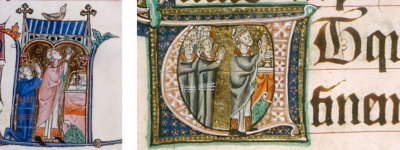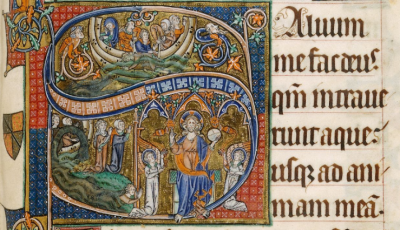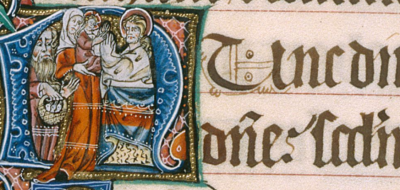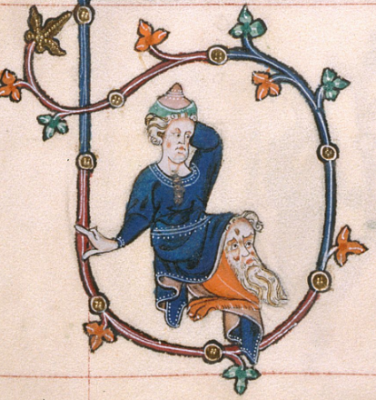I ett av våra sök efter dräkter med prickar och linjer går vi igenom The Gorleston Psaltar, 1310-1324, Add MS 49622
In our search for dresses with dots and lines we go throuh The Gorleston Psaltar, 1310-1324, Add MS 49622.
Det är ett manuskript med en fantastiskt tydlig handstil, som är lätt att läsa. Som alltid finns det en mängd förkortningar, men har man den latinska Versio Vulgata vid sidan på skärmen går det riktigt bra. Och om man blir osäker på betydelsen kan man alltid kolla i Psaltaren på svenska. Sådana här kända texter är en fröjd att läsa, till skillnad från andra, sekulära manuskript.
It is a manuscript with extremely clear handwriting,easy to read. As always there are a lot of abbreviations, but with the latin bible Versio Vulgata on the screen you can read very well. If being uncertain of the meaning you can always check the Psaltar in swedish. A text well known as this is a delight to read, unlike other, secular manuscripts.
På tal om handstil, så är de senare tilläggen, fol 226v ff, gjorda av en helt annan och senare hand, som skriver snabbt, men inte lika omsorgsfullt. Och skillnaden i stil ser man främst på bokstäverna a och d.
Talking about handwriting, the later additions, from fol 226v onwards, are made by another and later hand, fast writing but not careful. The difference in style can be seen mostly in the letters a and d.
När jag bläddrat mig igenom alla sidor ville jag läsa psaltarpsalmen ”Herren är min herde”, men till min förvåning finns den inte med i manuskriptet! Fol 31v hugger av ”skärtorsdagspsalmen” mitt i vers 28 och slutar med ”Dominum universi fines terrae”. Fol 32r börjar ”Domini est terra”. Man har helt enkelt hoppat över ”herdepsalmen”!
After browsing all the pages I wanted to read the Shepards Psalm ”The Lord is my Shepard”, but to my suprise it is not to be found in the manuscript! Fol 31v cuts the ”Maundy Thursday” Psalm just in the middle of verse 28 and ends with “Dominum universi fines terrae”. Fol 32r begins “Domini est terra”. The whole Shepards Psalm is omitted!
Men det är illuminationerna som egentligen står i fokus, även om så mycket annat i manuskriptet är intressant att fördjupa sig i. Alla dessa vinjetter, anfanger med personer, figurer i marginalen – vilka har dräkter med prickar och linjer?
But the focus in on the illuminations, although so many other things in the manuscript are interresting to go deeper into. All these vignettes, initials with people in, figures in the margin – who are wearing the dresses with dots and stripes?
Den första bilden finns i nedre marginalen på fol 11v och är en ovanligt stor illumination. Det visar en man med gloria, alltså ett helgon, på ett kors format som ett X. Alltså är det aposteln S Andreas. Två knäböjande munkar visar honom sin vördnad.
The first picture is found in the bottom margin on fol 11v and is a dominating large illumination. It shows a man with a halo – he is a saint – on a X-shaped cross. Thus it is the apostle S Andrew. Two kneeling monks are venerating him. Det finns en hel mängd bilder på apostlar i manuskriptet, men alla de övriga finns inskrivna i det slags anfang om två rader som inleder en ny psaltarpsalm. De allra flesta apostlarna är försedda med ett språkband med namnet, så de lättare ska kunna identifieras. Men jag visar bilden på en som också har ett språkband, men där står det ”In principio erat”, som är första orden i Johannes evangelium. Alltså är det aposteln/evangelisten S Johannes. Dessutom finns där en örn, som är hans symbol, som understryker identiteten.
Det finns en hel mängd bilder på apostlar i manuskriptet, men alla de övriga finns inskrivna i det slags anfang om två rader som inleder en ny psaltarpsalm. De allra flesta apostlarna är försedda med ett språkband med namnet, så de lättare ska kunna identifieras. Men jag visar bilden på en som också har ett språkband, men där står det ”In principio erat”, som är första orden i Johannes evangelium. Alltså är det aposteln/evangelisten S Johannes. Dessutom finns där en örn, som är hans symbol, som understryker identiteten.
There are a lot of pictures of apostles in the manuscript, but all the rest of them are inscribed in that kind of 2-row initials when a new Psalm begins. The most of the apostles have a speech band with the name on, to be easier to identify. But I will show the picture of one with a speech band where can be read ”In principio erat”, the first words in the gospel of S John. Thus it is the apostle/evangelist S John. Also there is seen an eagle, his symbol, to underline the identity. Men åter till S Andreas. Hans dräkt är tvärmönstrad med tre bårder, som var och en består av: våglinje, två raka linjer och en pricklinje. Mitt på varje ärm en bård med dubbel rak linje och pricklinje. Ärmen avslutas med prickad kant. Hans dräkt har mycket mer av sådan här dekor än de flesta andra personer i manuskriptet. När man bläddrar igenom det märker man att de personer som har enklare dekor på dräkterna är anonyma gestalter, och det fåtal som har mer utvecklad dekor är identifierade och betydelsefulla.
Men åter till S Andreas. Hans dräkt är tvärmönstrad med tre bårder, som var och en består av: våglinje, två raka linjer och en pricklinje. Mitt på varje ärm en bård med dubbel rak linje och pricklinje. Ärmen avslutas med prickad kant. Hans dräkt har mycket mer av sådan här dekor än de flesta andra personer i manuskriptet. När man bläddrar igenom det märker man att de personer som har enklare dekor på dräkterna är anonyma gestalter, och det fåtal som har mer utvecklad dekor är identifierade och betydelsefulla.
But back to S Andrew. His dress is cross patterned with three groups of one wavy line, two straight lines and one dotted line. In the middle of each sleeve there is a double straight line and a dotted one. Each sleeve has a dotted ending. His dress has much more decorations than mostly of the persons in the manuscript. Browsing through it you will notice that the persons with more simple decorations on the dresses are anonymius figures, and the few with more developed decoration are identified and important.
S Andreas avbildas här först av alla i raden av apostlar, där de övriga byggs in en anfang. Han får breda ut sig utan anfangens begränsande ram. Detta i ett manuskript med engelsk provinens. Det bör vara gjort med avsikt. Enligt Joh 1:40 är Andreas den förste lärjungen till Jesus och han hade när Gorleston Psaltar utfördes i århundraden varit särskilt vördad på de brittiska öarna. Den här bilden är betydelsefull, både vad gäller placering och utformning.
S Andrew is here painted first of all in the apostle row, and all the others are inscribed in an initial. He is allowed to spread out over the page without the limination of an initial. This in a manuscript of english origin. It has to be done with a purpose. According to John 1:40 Andrew is the first deciple of Jesus, and in that time the Gorleston Psaltar was made he had for centuries been particularly venerated on the British islands. The place and configuration of this picture has a certain significance.
Till skillnad från bilden av S Andreas är övriga illuminationer i marginalen utförda som allmän dekoration. Det är i bilderna i alla anfanger som man måste söka meningen och avsikten. Det gäller bara att komma på vilken!
Unlike the picture of S Andrew the rest of the margin illuminations are made as a general decoration. It is in the pictures in all the initials you must find the meaning and the purpose. Just to find out what!
Nu ska vi se på några dekorativa element i manuskriptet. Det är marginalfigurer av olika slag. Alla dessa har prickar och ränder. Fol 14v, 64v och 56r.
Now we will look on some decorative elements in the manuscript. They are figures of different kind. All have dots and stripes on their dresses. Fol 14v, 64v och 56r. Det förekommer bilder av mässor i marginalen (fol 13r) och som anfang (fol 94v) där mässtjänaren (?) och församlingen (?) har dräkter med prickar och linjer.
Det förekommer bilder av mässor i marginalen (fol 13r) och som anfang (fol 94v) där mässtjänaren (?) och församlingen (?) har dräkter med prickar och linjer.
Some pictures with masses occur in the margin (fol 13r) and in an initial (fol 94v). The mass servant (?) and the congregation (?) have dotted-lined dresses. Psaltaren har 150 psalmer och varje psalm inleds med en anfang om två rader, med något slag av illumination. Varje vers inleds med en enkel anfang om en rad. Psaltaren är indelad i avdelningar som var och en inleds med en anfang om sex rader. Som exempel på en sex raders anfang tar vi fol 86r. Där avbildas hur profeten Jona kastas i havet och sedan räddas. Det här är inledningen till psaltaren 68 ”Salvum me fac Deus” (i den nutida svenska psaltaren: Rädda mig, Gud! Vattnet når mig till halsen). Det måste varit avsiktligt som den här psalmen fått den här illustrationen.
Psaltaren har 150 psalmer och varje psalm inleds med en anfang om två rader, med något slag av illumination. Varje vers inleds med en enkel anfang om en rad. Psaltaren är indelad i avdelningar som var och en inleds med en anfang om sex rader. Som exempel på en sex raders anfang tar vi fol 86r. Där avbildas hur profeten Jona kastas i havet och sedan räddas. Det här är inledningen till psaltaren 68 ”Salvum me fac Deus” (i den nutida svenska psaltaren: Rädda mig, Gud! Vattnet når mig till halsen). Det måste varit avsiktligt som den här psalmen fått den här illustrationen.
The Psatler contain 150 psalms. Each psalm begin with a 2-row initial with some kind of illumination. Each verse begin with a simple 1-row initial. The Psaltar is diveded in parts and each part begin with a 6-row initial. As an example of this we take fol 86r. The profet Jona is thrown into the sea and later saved. This is the beginning of psalm 68 ”Salvum me fac Deus” (Save me, O God; for the waters are come in unto my soul.) It must been made intentionally that this psalm got this illustratration. I en två raders anfang D till psalm 97 ”Dominus regnavit”, fol 125r, ser vi en välsignande Kristus tronande på regnbågen och med jordgloben i sin hand. Eftersom det här är sista raderna på sidan kan nedre marginalens dekor inkorporeras i anfangen. Här i form av en riddare som lyfter sina händer i tillbedjan, eller håller och bär upp anfangen. Hur man nu vill tolka riddarens gest. Notera prickranden på riddarens surcot.
I en två raders anfang D till psalm 97 ”Dominus regnavit”, fol 125r, ser vi en välsignande Kristus tronande på regnbågen och med jordgloben i sin hand. Eftersom det här är sista raderna på sidan kan nedre marginalens dekor inkorporeras i anfangen. Här i form av en riddare som lyfter sina händer i tillbedjan, eller håller och bär upp anfangen. Hur man nu vill tolka riddarens gest. Notera prickranden på riddarens surcot.
In a 2-row initial D to psalm 97 ”Dominus regnavit”, fol 125r, a signing Christ is seen enthroned on the rainbow with an earth globe in his hand. Being on the last row on the page the bottom margin could be incorporated in the initial. Here as a knight, lifting his hand in worship or he just holds and support the initial. The gesture of the knight is open for interpretations. Note the dotted line on the knight´s surcote. Den sista bilden jag tar med ur Gorlestons psalteriet är från fol 205v. Anfangen N inleder ”Nunc dimittis” som är Simeons lovsång (Lukas 2:21f), en av de nytestamentliga cantica som också ingår i tidebönen som kyrkans aftonbön. Maria bär fram Jesusbarnet till Simeon. Josef bär en korg med duvor, ”som hörde till tackoffret ”. Notera att alla har dräkter med olika varianter av prickar och linjer.
Den sista bilden jag tar med ur Gorlestons psalteriet är från fol 205v. Anfangen N inleder ”Nunc dimittis” som är Simeons lovsång (Lukas 2:21f), en av de nytestamentliga cantica som också ingår i tidebönen som kyrkans aftonbön. Maria bär fram Jesusbarnet till Simeon. Josef bär en korg med duvor, ”som hörde till tackoffret ”. Notera att alla har dräkter med olika varianter av prickar och linjer.
As the last picture from the Gorleston Psaltar I will take the one from fol 205v. The initial N is the first letter in ”Nunc dimittis”, Symeon´s praise (Luk 2:21ss), one of the cantica from the New Testament, also used in the evening prayer of the Church. S Mary carry forward the child Jesus to Symeon, Joseph carry a basket with doves, ”according to that which is said in the law” Note that all three of them have dresses with variuos decoration of dots and lines. Men jag kunde inte låta bli att ta med den här marginalfiguren i fol 103v.
Men jag kunde inte låta bli att ta med den här marginalfiguren i fol 103v.
But I could not let this margin figure on fol 103v being unseen.

